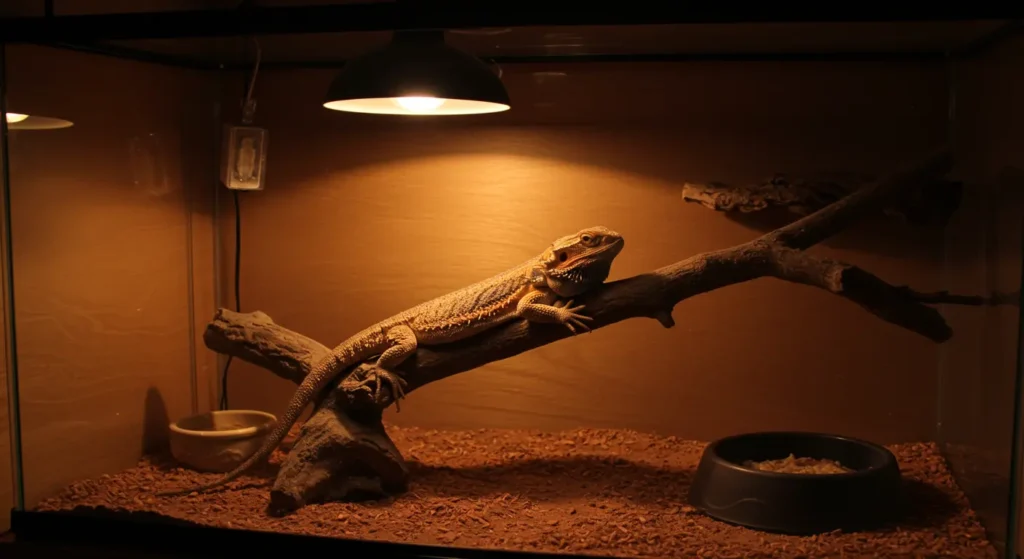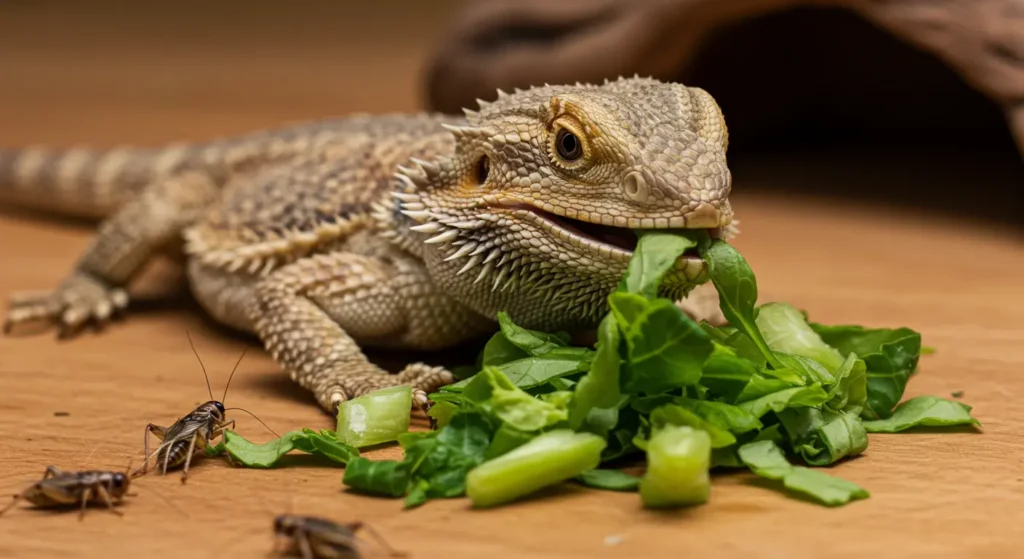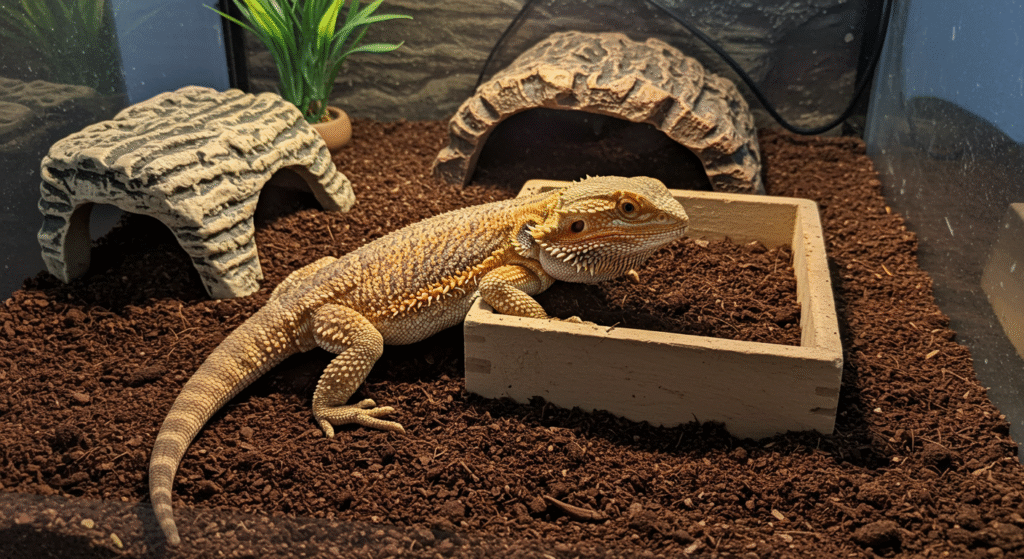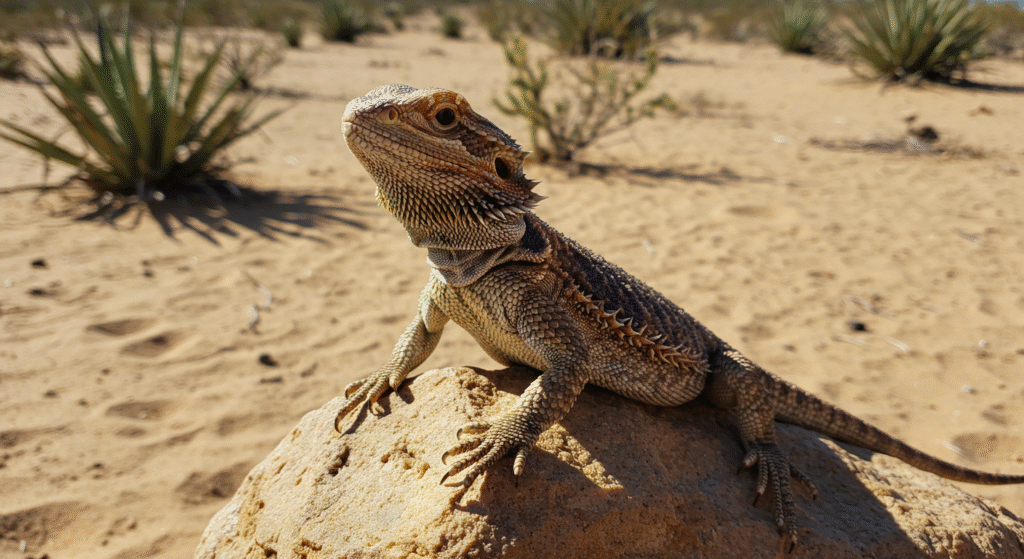The female bearded dragon is a fascinating and often misunderstood pet. Many reptile owners focus on males, but females have their own unique needs and behaviors. If you’re caring for a female bearded dragon, it’s important to know what sets her apart.
She may display mood changes, dig frequently, or even lay eggs without mating. These behaviors can surprise new owners. Understanding them helps you provide the right care.
In this guide, you’ll learn how to identify a female bearded dragon, create a proper habitat, and manage her health. We’ll also cover behavior tips and what to expect during egg-laying.
Whether you already own a female bearded dragon or plan to get one soon, this article gives you the knowledge you need to help her thrive.

How to Tell If Your Bearded Dragon Is Female
Knowing your bearded dragon’s gender is essential for proper care. Female and male bearded dragons show differences that help you identify them early on. This section explains key physical traits and safe methods to confirm if your pet is female.
Key Physical Differences Between Male and Female Bearded Dragons
Female bearded dragons exhibit clear physical differences compared to males, which helps in identifying their gender. One of the most noticeable signs is the size of the femoral pores found on their thighs. Female bearded dragons have smaller and less obvious pores, while males have larger, more prominent bumps. Additionally, females have slimmer tails without the characteristic hemipenal bulges seen on males near the tail base. The shape of their heads also differs — females usually have softer, narrower heads, in contrast to the broader and more angular heads of males. These traits may not be obvious in very young dragons but become clearer with age, making it easier to identify a female bearded dragon as they mature.
How to Safely Sex a Bearded Dragon at Home
You can safely check if your bearded dragon is female by gently lifting its tail near the base. Using your thumb and forefinger, carefully part the scales to observe the area for hemipenal bulges, which indicate a male. If no bulges are visible and the area appears smooth, your pet is most likely a female bearded dragon. It’s important to be gentle and calm during this process to avoid causing stress or injury to your pet. Using good lighting will help you see the details clearly. This method works best once your dragon has grown enough to show these physical differences. Make sure to wash your hands before and after handling to maintain hygiene and reduce stress on your dragon.
When Can You Accurately Tell the Gender?
It’s best to wait until your bearded dragon is at least 4 to 6 months old before trying to identify if it is female or male. Juvenile dragons have subtle physical differences, making it harder to determine their gender accurately. As your bearded dragon matures, key traits such as femoral pore size, tail shape, and head structure become more distinct. Attempting to sex your dragon too early can lead to mistakes and confusion. Waiting until the right age ensures you can confidently recognize if your pet is a female bearded dragon and provide the appropriate care for its stage of life. Patience during this period can prevent unnecessary stress for both you and your pet.
Should You Consult a Vet for Confirmation?
If you are unsure about your bearded dragon’s gender after examining it yourself, consulting a reptile veterinarian is highly recommended. Veterinarians have the expertise and equipment to accurately determine whether your pet is a female bearded dragon. They may perform a detailed physical exam or use imaging techniques such as ultrasound or X-rays to confirm the gender. Getting professional confirmation guarantees you can offer the best care, especially if you plan to breed or closely monitor your dragon’s health. This step ensures peace of mind and proper management tailored to your female bearded dragon. Vets can also provide advice on specific health and behavioral traits related to gender.
Female Bearded Dragon Care Essentials
Proper care is vital to keep your female bearded dragon healthy and happy. Setting up the right environment, feeding a balanced diet, and maintaining hygiene are the core pillars of good care. This section breaks down these essentials in detail.
Ideal Tank Setup and Lighting for Female Dragons
An ideal tank setup plays a major role in the health of your female bearded dragon. A full-grown female should have a tank that holds at least 40 gallons, though larger enclosures are even better. Space is important, especially for females that may lay eggs and need room to dig or move freely. Include a solid basking platform where temperatures stay between 95–110°F and make sure the cool side of the tank remains between 75–85°F. Proper heat helps with digestion and energy. UVB lighting is absolutely essential for calcium absorption and bone health. Without UVB, your female bearded dragon can develop serious issues like metabolic bone disease. Change the UVB bulb every 6 to 12 months to maintain effectiveness. A clean, well-lit, and temperature-controlled habitat is the foundation of good care.
Proper Diet and Supplements (Calcium, Greens, and Insects)
Feeding your female bearded dragon the right diet is key to her overall health. Females, especially those preparing to lay eggs, need extra calcium and well-balanced meals. A proper diet includes a variety of leafy greens such as collard greens, mustard greens, and dandelion leaves. These provide essential vitamins and support bone strength. Pair greens with gut-loaded insects like dubia roaches, crickets, and the occasional mealworm for protein. Avoid feeding iceberg lettuce and high-oxalate foods like spinach, which interfere with calcium absorption. Most importantly, dust her food with calcium powder several times a week to support reproductive and bone health. This is especially critical for females who may lay infertile eggs. To learn more about insect feeding schedules, visit our expert-backed guide on what insects bearded dragons can eat daily. Providing the right mix of nutrients will keep your female bearded dragon strong and active.

Hydration and Bathing Routine
Hydration is often overlooked, but it’s very important for your female bearded dragon’s health. Always keep a shallow dish of clean water in her tank. Some dragons may not drink directly from it, but the water still helps maintain humidity and gives them a chance to hydrate. In addition to drinking, bathing your female bearded dragon two to three times per week offers several benefits. Use lukewarm, chlorine-free water and soak her gently for 10 to 15 minutes. Baths aid in hydration, help with shedding, and can even ease mild constipation. Female dragons may also be more prone to impaction, especially if they’re not digesting calcium or insects properly. Regular bathing keeps their digestive system running smoothly. Make bath time a calm experience, and always dry her off gently afterward to prevent chills.
Common Health Problems in Female Bearded Dragons
Like all reptiles, female bearded dragons can face health problems — but many of these can be avoided with the right care. One of the most serious issues is egg binding, where a female retains eggs and cannot lay them. This is life-threatening and requires immediate veterinary help. Female dragons also face a higher risk of metabolic bone disease, often caused by a lack of calcium or inadequate UVB lighting. Symptoms include weak limbs, tremors, or deformities. Parasites are another concern and may cause weight loss, lethargy, or abnormal stools. Regular vet checkups and fecal tests help catch these problems early. Keep an eye on behavior changes — a sudden lack of appetite or hiding could signal illness. Preventing these issues starts with proper diet, lighting, hydration, and regular health monitoring. By staying proactive, you can protect your female bearded dragon from many common problems.
Understanding Female Bearded Dragon Behavior
Understanding your female bearded dragon’s behavior will improve your bond and help spot health issues early. Their actions vary with seasons and moods. This section covers typical behaviors and what they mean.
Natural Female Behaviors During Breeding Season
During the breeding season, it’s normal for a female bearded dragon to display unique behaviors even if there is no male around. These actions are driven by hormones and can include digging, restlessness, and a sudden increase or decrease in appetite. Your female may also scratch at the corners of her tank or look for places to nest. This is a sign that her body is preparing to lay eggs, which can happen even if they are infertile. Providing a soft, diggable area such as a lay box filled with moist soil or sand helps ease this instinctual behavior. Without a proper nesting spot, your female bearded dragon may become stressed. Monitoring her behavior closely during this season ensures she remains calm, healthy, and safe.
Aggression, Head Bobbing, and Arm Waving
Female bearded dragons use body language to communicate, and understanding these movements can help you respond appropriately. Head bobbing is typically a sign of dominance, especially if done quickly and repeatedly. In contrast, arm waving is a submissive gesture, often seen in younger dragons or females acknowledging another dragon’s presence. Mild aggression may also occur, including behaviors like tail whipping, open-mouth posturing, or even gentle biting. These signs are often responses to environmental changes, feeling threatened, or territorial instincts. It’s important to give your female bearded dragon space if she shows signs of stress or agitation. Avoid handling her too much during these times and ensure her enclosure offers hiding spots to retreat. Recognizing these signals helps you maintain a calm, respectful relationship with your dragon.
What to Expect During Brumation
Brumation is a natural resting period similar to hibernation that many bearded dragons, including females, go through during cooler months. Your female bearded dragon may become sluggish, sleep more often, and lose interest in food. While this behavior can be alarming to new owners, it’s completely normal for a healthy dragon. During brumation, your dragon still needs access to clean water and consistent lighting. Even if she doesn’t eat, hydration is important. Avoid force-feeding, but do monitor her weight and behavior weekly. If you’re unsure whether she’s brumating or ill, consult a reptile vet. Providing a quiet, stable environment will help her complete this natural cycle safely. Understanding what brumation looks like helps you stay calm and offer the right care during this dormant phase.
Signs of Stress or Discomfort in Enclosure
A female bearded dragon will often show clear signs when she’s stressed or uncomfortable in her environment. Common indicators include “glass surfing,” where she repeatedly scratches at or runs against the tank walls, as well as darkening of the beard or body, hiding excessively, and loss of appetite. These behaviors usually mean something in her enclosure is off — it could be the temperature, lighting, noise levels, or even tank size. Always check that the basking and cool zones are within recommended ranges and that she has hiding spots and visual barriers. A dirty tank or overcrowded space can also lead to stress. Adjusting the setup based on her behavior ensures your female bearded dragon feels safe, secure, and at ease in her habitat.
What to Do If Your Female Bearded Dragon Lays Eggs
Egg-laying is a natural part of a female bearded dragon’s life cycle, even if no male is present. Understanding the signs and proper care can help ensure her health and comfort. This section guides you through recognizing gravid signs, preparing a suitable area, and post-laying care.
Gravid Signs: How to Know She’s About to Lay Eggs
Recognizing when your female bearded dragon is gravid — meaning she is carrying eggs — is crucial for providing the right care. Common signs include a noticeably swollen or firm belly, especially on the lower abdomen. You may also notice her appetite increasing or changing, as well as more frequent digging behaviors in her enclosure. Some females become restless, pacing or scratching at corners as they search for a place to lay. In some cases, she may also become more lethargic, sleep longer, or show a reduced interest in food as egg-laying nears. It’s important to monitor her closely and offer a calm, safe space. Recognizing these signs early helps you prepare a proper nesting area and avoid stress or complications during the laying process.
Setting Up a Lay Box or Digging Area
A proper lay box is essential when your female bearded dragon shows signs of being gravid. Without a suitable place to lay, she may become anxious or retain her eggs, which can lead to serious health issues. To create a lay box, use a plastic container or bin that’s large enough for her to turn around in. Fill it with 4 to 6 inches of moist, loose substrate — such as play sand, topsoil, or coconut fiber. The substrate should be firm enough to dig but soft enough to hold its shape. Place the box either in her enclosure or right next to it, so she can access it easily. Make sure temperatures in the area are warm and consistent. This setup encourages natural digging behavior and gives your female bearded dragon a safe, stress-free space to lay her eggs.

Aftercare for a Female That’s Laid Eggs
Once your female bearded dragon lays her eggs, she will need time and support to recover fully. Egg-laying takes a lot of energy and can leave her temporarily depleted, especially if it was a large clutch. Right after laying, offer her a warm, quiet environment with easy access to food and water. Focus on feeding calcium-rich greens and gut-loaded insects to replenish lost nutrients. You should also dust her food with calcium powder for the next several days. Continue to monitor her closely — if she shows signs of ongoing lethargy, bloating, or a darkened beard, contact a reptile vet immediately. These could be signs of retained eggs or egg binding. Providing proper aftercare ensures your female bearded dragon recovers safely and remains healthy for future cycles.
What If There’s No Male? Understanding Infertile Eggs
Even if your female bearded dragon has never been with a male, she can still lay eggs — but these are infertile and won’t hatch. This may seem surprising, but it’s a completely natural hormonal response that often happens during the breeding season. While harmless in most cases, frequent laying of infertile eggs can take a toll on her health by depleting her calcium reserves and overall energy. To help minimize this, offer a diet rich in calcium and ensure she gets proper UVB exposure every day. Reducing high-protein intake and adjusting light cycles in early spring can also help manage hormonal activity. For a more detailed breakdown of bearded dragon eggs — including handling, fertility, and aftercare — check out this helpful guide from The Spruce Pets: Bearded Dragon Eggs – Everything You Need to Know. Keeping informed can make a big difference in your dragon’s long-term health.
Lifespan, Size, and Long-Term Health Tips
Knowing what to expect about size, lifespan, and health helps you plan for your bearded dragon’s care. Females have specific needs as they grow and age. This section provides key insights to support her wellbeing throughout her life.
Average Size and Growth Expectations
Female bearded dragons typically grow to about 16 to 24 inches in total length, including their tail. The average female is slightly smaller than her male counterpart, but this depends on genetics, diet, and overall health. Growth is most rapid during the first 6 to 12 months of life, and most females reach full size by 12 to 18 months of age. A diet rich in calcium, protein, and fresh vegetables plays a major role in proper development. Poor nutrition or inadequate UVB exposure can stunt growth and weaken bones. Keeping a regular feeding schedule and providing a warm, spacious enclosure will allow your female bearded dragon to grow strong and healthy. Tracking her size with monthly measurements is a helpful way to monitor development.
How Long Do Female Bearded Dragons Live?
With excellent care, a female bearded dragon can live 8 to 12 years, and in some cases even longer. Lifespan depends on genetics, diet, enclosure quality, and how early health issues are detected and addressed. Females may experience more physical strain over their lives due to egg production, even if eggs are infertile. That’s why preventive care and nutritional support are so important. Offering a stable routine, avoiding stress, and keeping her enclosure clean all contribute to long-term wellbeing. While some female bearded dragons live shorter lives due to poor care or reproductive complications, many can thrive for over a decade in a properly maintained environment. Lifespan is not just about time — it’s about quality of life, and consistent care is key.
Preventing Egg Binding and Reproductive Illnesses
Egg binding is a serious, potentially fatal condition where a female bearded dragon is unable to pass her eggs. It often results from poor calcium intake, lack of proper nesting sites, or high stress levels. To prevent this, always provide a lay box if your female shows signs of being gravid — even if she hasn’t been with a male. Supplement her diet with calcium, especially during the breeding season, and ensure she receives proper UVB lighting daily. Signs of egg binding include lethargy, bloating, straining without laying, or refusal to eat. If you suspect a problem, seek veterinary help immediately. Preventing reproductive issues like egg binding is critical to protecting your female bearded dragon’s health and avoiding painful, costly complications.
When to See a Reptile Vet for Routine Checkups
Even if your female bearded dragon seems perfectly healthy, regular veterinary checkups are an important part of her care. A reptile-experienced vet can help detect health problems early — before they become serious. It’s recommended to schedule an annual wellness exam to monitor her weight, hydration, skin condition, and overall development. Female dragons are especially prone to calcium deficiency and reproductive issues, so your vet may check for signs of egg binding or follicular stasis. If you notice any behavioral changes, such as decreased appetite, darkening of her beard, or frequent hiding, don’t wait — book a visit. Staying ahead of problems with regular vet care ensures your female bearded dragon enjoys a long, healthy life with minimal complications.
Final Thoughts: Give Your Female Bearded Dragon the Life She Deserves
Caring for a female bearded dragon is more than just feeding her and keeping her warm — it’s about understanding her unique behaviors, physical changes, and emotional needs throughout every stage of her life. From identifying her gender correctly to creating a stress-free habitat, each thoughtful action you take plays a key role in her health and happiness. Female bearded dragons have special requirements, especially when it comes to reproduction, brumation, and long-term wellness. Being aware of these needs allows you to respond with confidence rather than confusion.
By observing her closely, offering proper nutrition, and staying consistent with her environment, you can prevent many common issues before they arise. Whether she’s digging for a place to lay eggs or slowing down for brumation, your support and care will help her feel safe and understood.
This guide has equipped you with the knowledge to make smart, compassionate decisions that benefit your female bearded dragon every day. In return, she’ll reward you with trust, quirky personality traits, and a lasting companionship that makes all the effort worthwhile. With the right approach, your journey together can be one of joy, growth, and lasting memories.






